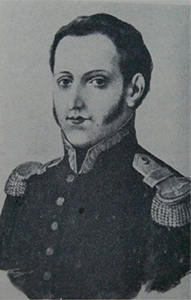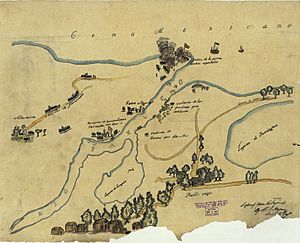Isidro Barradas facts for kids
Isidro Plácido Del Rosario Barrada y Valdéz was a Spanish general. In 1829, he was sent to Mexico. This was eight years after Mexico became independent. General Barradas tried to take Mexico back for the Spanish king. But his attempt was not successful.
Contents
Why Spain Tried to Reconquer Mexico
After Mexico won its independence, some laws were made. In 1827, Mexico passed a law called the General Law of Expulsion. This law said that all foreigners, especially Spaniards, had to leave the country.
In January 1829, the Mexican government learned something important. A Spanish force was getting ready in Havana, Cuba. Their goal was to reconquer Mexican land.
Barradas's Expedition
Spanish Brigadier Isidro Barradas arrived secretly in Havana on June 2, 1829. He gathered a large group of soldiers. There were about 3,000 to 4,000 men. On July 5, he sailed for Mexico. His fleet included one large warship, two smaller warships, two gunboats, and 15 transport ships. Admiral Ángel Laborde led the fleet.
Many Spaniards who had been forced to leave Mexico in 1827 joined this expedition. They wanted to return to their homes. These exiles told Barradas that Mexicans wanted to be part of Spain again.
Barradas was not easy to get along with. He often argued with Admiral Laborde. His own soldiers generally did not like him.
The Storm at Sea
Three days after leaving Havana, a strong storm hit the fleet. This happened in the Bay of Campeche. The ships were scattered. Their meeting point was Isla de Lobos, near Veracruz. But the bad weather made it hard to gather again.
By July 22, almost all the ships had reached the meeting point. One transport ship with 400 soldiers had to go to New Orleans for repairs.
Landing in Mexico
On July 26, the fleet arrived near Cabo Rojo, close to Tampico. The next day, they tried to land 750 men in 25 small boats. But the waves were too strong. Admiral Laborde offered a reward to anyone who would swim ashore. He wanted news about Mexico's defenses.
Eugenio Aviraneta e Ibargoyen accepted the challenge. He swam ashore with some gold and messages. He spoke to four local Huasteco people. They told him there were no soldiers nearby. But they said General Lagarza was in Tampico with a thousand troops. He was there to stop any uprising by Antonio López de Santa Anna. Aviraneta learned that Lagarza did not know the Spaniards had arrived.
The Huastecos showed him the best place to land. They refused to go to Tampico with him, fearing punishment. The landing began at 2:00 that afternoon. The Spanish force started marching toward Tampico. The Spanish ships sailed to the Río Pánuco.
On July 31, the first fight with Mexican forces happened. This was at Los Corchos, about 20 kilometers southeast of Pueblo Viejo, Veracruz.
Meanwhile, Santa Anna had been getting ready for the invasion. He had gathered 1,000 foot soldiers, 500 cavalry, and four cannons. He also had a small fleet of ships. Santa Anna did not attack directly. Instead, he surrounded Barradas's forces.
Surrender of Barradas
On September 11, 1829, General Barradas's troops were weak. They were cut off from supplies and many were sick. Barradas signed an agreement called the Capitulation of Pueblo Viejo. He signed it with Santa Anna and General Manuel Mier y Terán.
Santa Anna was seen as a hero. People called him the "savior of the Republic." This event was the final step in Mexico becoming truly independent.
President Vicente Guerrero had sent Santa Anna to fight the Spanish. He also sent Vice-President General Anastasio Bustamante to Jalapa. Bustamante's troops were a backup in case of other Spanish landings. Bustamante used this chance to lead his troops in a revolt. He overthrew President Guerrero.
See also
 In Spanish: Isidro Barrada Valdés para niños
In Spanish: Isidro Barrada Valdés para niños
- Mexico-Spain relations



